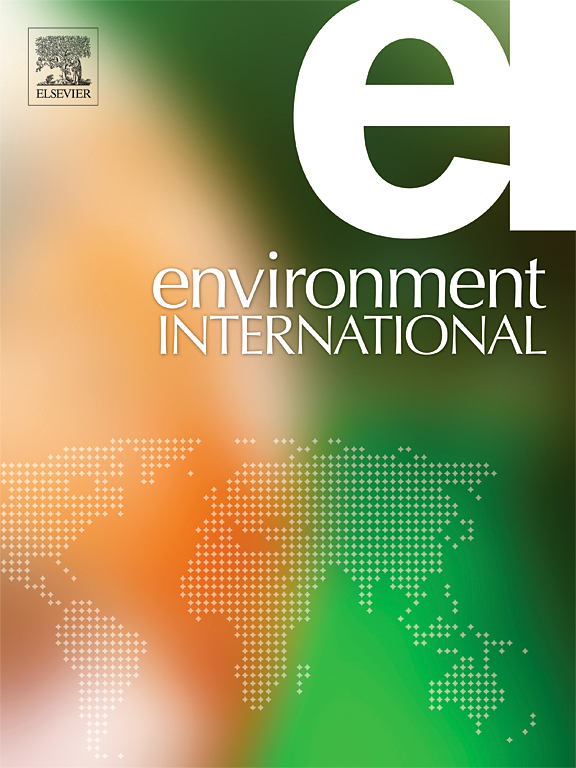Global analysis links ambient fine particulate matter to bacterial antimicrobial resistance based on 110,000 + genomes
IF 9.7
1区 环境科学与生态学
Q1 ENVIRONMENTAL SCIENCES
引用次数: 0
Abstract
Antimicrobial resistance (AMR) is a global health challenge. Recently, overwhelming evidence suggests a possible association between fine particulate matter (PM2.5) and bacterial AMR. However, the PM2.5-AMR association was poorly understood. In this global analysis, we aim to provide an in-depth and comprehensive insight into the PM2.5-AMR association. Based on multiple global databases, two Bayesian multivariable models (negative binomial regression model and logistic regression model) with different lag time were used to estimate the association, quantify the lag-response effects, and identify potential effect modifiers. A total of 114,488 isolates with genome data, collected between 2000 and 2022 from 139 countries and regions, were examined. For every 10 μg/m3 increase in PM2.5 exposure over the past 12 months, there was a corresponding 11.2 % increase (95 % CI: 10.6 %, 11.7 %) in the percentage of total resistance genes per isolate and an odds ratio of 1.18 (95 % CI: 1.17, 1.20) for carrying at least one resistance gene. There was a dose–response relationship between PM2.5 level and AMR. The PM2.5-AMR association might be highest at cumulative exposure during the past 12 months, and modified by bacterial species, sample sources, environmental factors, and other national-level economic, medical, and social factors. To summarize, we found significant associations between PM2.5 exposure and AMR. Further studies are needed in phenotypic resistance data and possible intervention experiments in animals or humans to confirm these findings.
基于11万个 + 基因组的全球分析将环境细颗粒物与细菌抗菌素耐药性联系起来
抗微生物药物耐药性(AMR)是一项全球卫生挑战。最近的大量证据表明,细颗粒物(PM2.5)与细菌抗菌素耐药性之间可能存在关联。然而,人们对PM2.5-AMR的关联知之甚少。在这一全球分析中,我们的目标是为PM2.5-AMR关联提供深入和全面的见解。基于多个全局数据库,采用两种不同滞后时间的贝叶斯多变量模型(负二项回归模型和logistic回归模型)估计相关性,量化滞后反应效应,识别潜在的效应修饰因子。研究人员对2000年至2022年间从139个国家和地区收集的114,488株具有基因组数据的分离株进行了检测。在过去的12 个月里,PM2.5暴露每增加10 μg/m3,每个分离物的总抗性基因百分比相应增加11.2 %(95 % CI: 10.6 %,11.7 %),携带至少一种抗性基因的比值比为1.18(95 % CI: 1.17, 1.20)。PM2.5水平与AMR呈剂量-反应关系。在过去12个 月的累积暴露中,PM2.5-AMR相关性可能最高,并受细菌种类、样本来源、环境因素和其他国家级经济、医疗和社会因素的影响。总之,我们发现PM2.5暴露与AMR之间存在显著关联。表型耐药数据和可能的动物或人类干预实验需要进一步的研究来证实这些发现。
本文章由计算机程序翻译,如有差异,请以英文原文为准。
求助全文
约1分钟内获得全文
求助全文
来源期刊

Environment International
环境科学-环境科学
CiteScore
21.90
自引率
3.40%
发文量
734
审稿时长
2.8 months
期刊介绍:
Environmental Health publishes manuscripts focusing on critical aspects of environmental and occupational medicine, including studies in toxicology and epidemiology, to illuminate the human health implications of exposure to environmental hazards. The journal adopts an open-access model and practices open peer review.
It caters to scientists and practitioners across all environmental science domains, directly or indirectly impacting human health and well-being. With a commitment to enhancing the prevention of environmentally-related health risks, Environmental Health serves as a public health journal for the community and scientists engaged in matters of public health significance concerning the environment.
 求助内容:
求助内容: 应助结果提醒方式:
应助结果提醒方式:


